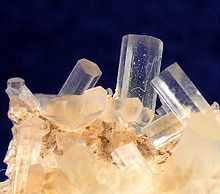Thaumasite
| Thaumasite | |
|---|---|
 Thaumasite (white) with prehnite (green) from Fairfax Quarry, Virginia | |
| General | |
| Category | Sulfate minerals |
| Formula (repeating unit) |
Ca3Si(OH)6(CO3)(SO4)·12H2O |
| Strunz classification | 07.DG.15 |
| Crystal symmetry | Hexagonal 6 |
| Unit cell | a = 11.030(7) Å, c = 10.396(6) Å; Z = 2 |
| Identification | |
| Formula mass | 622.62 g/mol |
| Color | Colorless, white, pale yellow |
| Crystal habit | Prismatic, fibrous, massive, radial |
| Crystal system | Hexagonal dipyramidal |
| Cleavage | Indistinct |
| Fracture | Subconchoidal |
| Tenacity | Brittle |
| Mohs scale hardness | 3.5 |
| Luster | Vitreous to silky |
| Streak | White |
| Diaphaneity | Transparent to translucent |
| Specific gravity | 1.877 |
| Optical properties | Uniaxial (-) |
| Refractive index | nω = 1.498–1.507 nε = 1.458–1.470 |
| Birefringence | δ = 0.039 |
| References | [1][2][3] |
Thaumasite is a silicate mineral with chemical formula Ca3Si(OH)6(CO3)(SO4)·12H2O. It occurs as colorless to white prismatic hexagonal crystals, typically as acicular radiating groups. It also occurs as fibrous masses. Its Mohs hardness is 3.5 and it has a specific gravity of 1.88 to 1.90. Optically it is uniaxial negative with indices of refraction of nω = 1.507 and nε = 1.468.

It occurs as a hydrothermal alteration mineral in sulfide ore deposits and geothermal alteration of basalt and tuff. It occurs with zeolites, apophyllite, analcime, calcite, gypsum and pyrite.[1]
Thaumasite can also be formed along with other calcium silicate hydrates (CSH) during cement alteration, especially when sulfate attack develops.
It was first described in 1878 in Sweden and named from the Greek, "thaumazein", to be surprised, in reference to its unusual composition with carbonate, sulfate and hydroxysilicate anions.[3]
The silicate structure of thaumasite is unusual due to the presence of non-tetrahedral silicon in its crystal lattice.[4][5] Indeed, an atypic octahedral configuration is observed for Si present in thaumasite in the form of hexahydroxysilicate: [Si(OH)6]2−, a species exhibiting a geometry similar to that of the hexafluorosilicate [SiF6]2−.
See also
References
- ↑ 1.0 1.1 Mineral Handbook
- ↑ Webmineral data
- ↑ 3.0 3.1 Mindat.org
- ↑ Duffy, J. A.; D. E. Macphee (2007). "The coordination number of silicon in silicon−oxygen compounds: The special case of 6-fold coordination in thaumasite". The Journal of Physical Chemistry B 111 (30): 8740–8745. doi:10.1021/jp071343n.
- ↑ Jacobsen, S. D.; J. R. Smyth, R. J. Swope (2003-07-01). "Thermal expansion of hydrated six-coordinate silicon in thaumasite, Ca3Si(OH)6(CO3)(SO4)·12H2O". Physics and Chemistry of Minerals 30 (6): 321–329. Bibcode:2003PCM....30..321J. doi:10.1007/s00269-003-0328-0.
Further reading
Aguilera, J.; S. Martínez-Ramírez, I. Pajares-Colomo, M. T. Blanco-Varela (December 2003). "Formation of thaumasite in carbonated mortars". Cement and Concrete Composites 25 (8): 991–996. doi:10.1016/S0958-9465(03)00121-5. ISSN 0958-9465. Retrieved 2010-08-03.
Barnett, S. J.; C. D. Adam, A. R. W. Jackson (2000). "Solid solutions between ettringite, Ca6Al2(SO4)3(OH)12·26H2O, and thaumasite, Ca3SiSO4CO3(OH)6·12H2O". Journal of Materials Science 35 (16): 4109–4114. Bibcode:2000JMatS..35.4109B. doi:10.1023/A:1004898623884.
Barnett, S. J.; D. E. Macphee, E. E. Lachowski, N. J. Crammond (May 2002). "XRD, EDX and IR analysis of solid solutions between thaumasite and ettringite". Cement and Concrete Research 32 (5): 719–730. doi:10.1016/S0008-8846(01)00750-5. ISSN 0008-8846. Retrieved 2010-08-03.